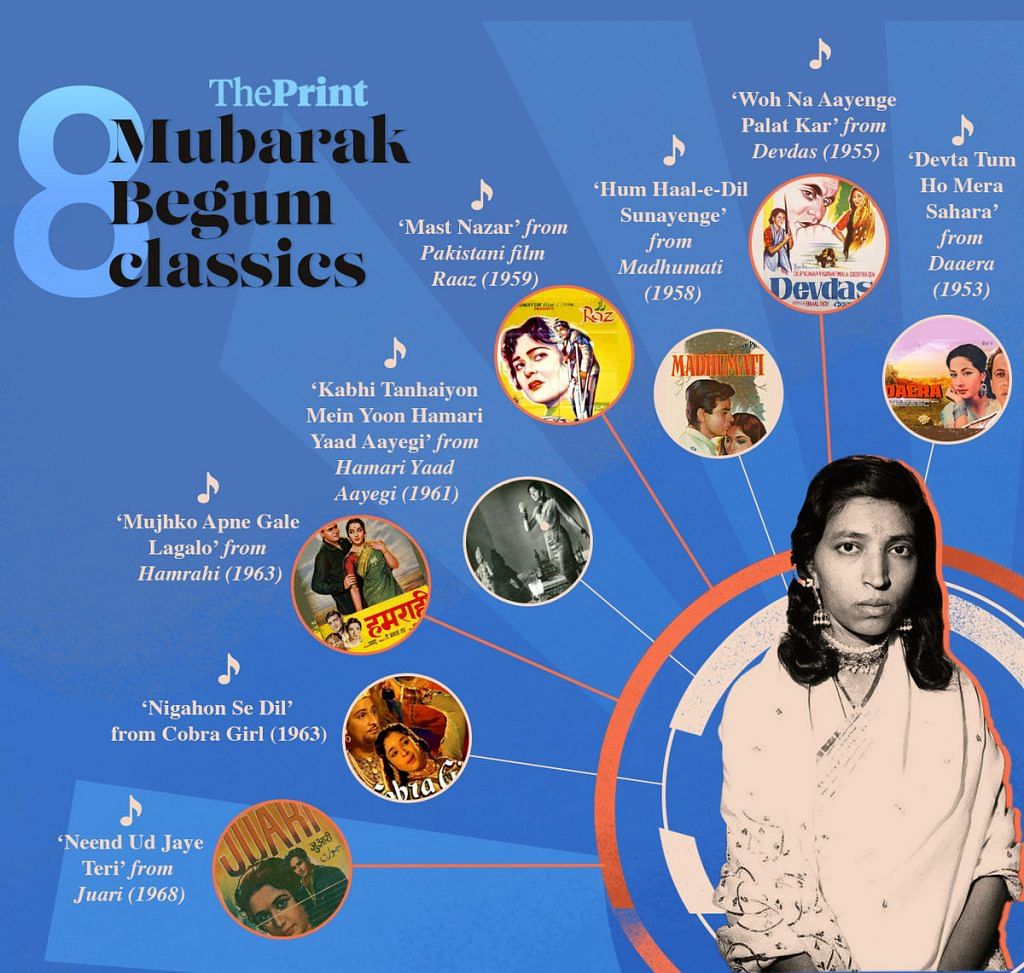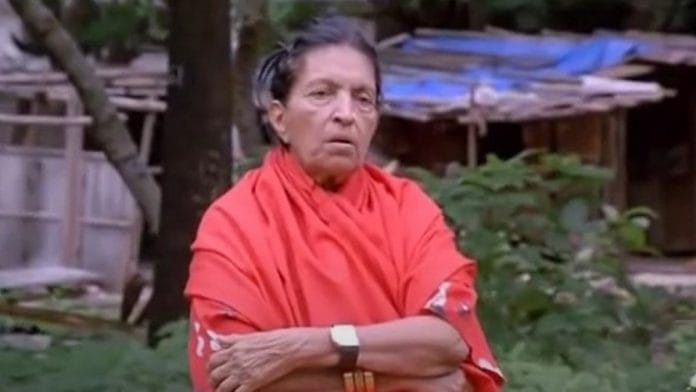Long before Nazia Hassan or Ali Zafar, there was Mubarak Begum, the original crossover singer. She lent her voice not just to many Bollywood hits in the 1950s and 60s but also sang for Pakistani films. Her singing was emotive, with a hint of salt, standing out from the sweeter voices that dominated the era. Yet, her career never reached the soaring heights of her voice, and she spent her final years in poverty in a tiny flat in Mumbai’s Jogeshwari.
“Unhoney mere parr kaat diye (they cut my wings),” she said in an interview with author Manek Premchand for his book The Hindi Music Jukebox: Exploring Unforgettable Songs. He titled the chapter on Mubarak Begum ‘The Flightless Bird of Hindi Playback Singing’.
But in her prime, brief as it turned out to be, Begum worked with the cream of music directors and lyricists, from SD Burman, Naushad, and SN Tripathi to Sahir Ludhianvi and Kaif Bhopali. Out of the 170-odd songs credited to her, several are evergreen classics, from the plaintive breakup staple ‘Kabhi Tanhaiyon Mein’ from Hamari Yaad Aayegi (1961) to ‘Mujhko Apne Gale Lagalo’ from Hamrahi (1963), a playful duet with Mohammed Rafi.
For some years, the Rajasthan-born singer, whose father was a fruit seller, seemed to have a charmed life, thumbing her nose at her humble origins. She was often compared to Lata Mangeshkar and counted stars like Meena Kumari among her friends.

Yet, shortly before her death at the age of 80, she gloomily recounted in an interview with Filmfare that she believed it all came crumbling down because of cutthroat competition even though composers still wanted to work with her.
“I stopped getting work from 1965. Some leading singers didn’t want me to succeed,” she claimed. “My records used to be sold out even before the films released. But slowly my songs were cut out. They made sure I got no work. They threw me out.”
But for some of her admirers, Mubarak Begum was simply born ahead of her time, refusing to be pegged into any one genre or style.
Also Read: The grand musician — Naushad Ali gave Lata Mangeshkar her big break
An early talent
Born in Rajasthan in 1936, Mubarak Begum might have led an unremarkable life if not for her father’s passion for music. Though he sold fruit for a living, he loved playing the tabla and often took the family to the cinema to break the monotony of daily life.
“I’d just keep watching films and copying the songs of Noor Jehan and Suraiya,” Mubarak Begum said in a 2007 Films Division documentary about her.
When she was just a young girl, Begum’s father awoke to his daughter’s innate musicality and started making big plans for her. The family moved to Gujarat and she was placed under the tutelage of Riazuddin Khan of the Kirana Gharana for a couple of years.
And then, he decided that she was ready to take on Mumbai.
At just 13, Begum overcame stage fright to sing at All India Radio (AIR) in Mumbai. Her melodious voice caught the attention of Pakistani music composer Nashad, who offered her a big break to sing for the movie Aeeye (1949) alongside another rising star—Lata Mangeshkar.
In her debut, Begum emulated Noor Jehan’s style in ‘Mohe Aane Lagi Angdaai’ and her duet ‘Aaiye Aao Chalen Chalen Wahan’ with Mangeshkar.
In 1953, she sang a bhajan for Kamal Amrohi’s film Daera. The song fared much better than the movie, which flopped at the box office. Two years later, she performed the heart-wrenching solo ‘Woh Na Aayenge Palat Kar’ in Bimal Roy’s Devdas, composed by the legendary SD Burman.
For the next two decades, it seemed Bollywood had given Begum a ticket out of poverty.
“I took to singing to look after my family. I didn’t come here for name or fame,” she said in the 2016 Filmfare interview.
Also Read: Surinder Sonia made Chamkila famous but Imtiaz Ali’s film reduces her to a footnote
Fading career, evergreen legacy
Mubarak Begum is recognised as a trendsetter for Indian singers crossing the border to charm Pakistani audiences. She first visited Lollywood to lend her voice to Bada Aadmi (1957) and followed it up by singing for the hit Raaz (1959).
In 1961, she recast the mould with the haunting ‘Kabhi Tanhaiyon Mein’ for Kidar Sharma’s Hamari Yaad Aayegi. This soulful song was a far cry from the sensuous ‘mujra’ songs that had defined her career until then. It became one of her most popular renditions—and also a swan song of sorts.
After a string of duets in 1963, including ‘Mujhko Apne Gale Laga Lo’ with Mohammed Rafi and ‘Hume Dum Daike Souten Ghar Jaana’ with Asha Bhosle, Begum’s career descended into a lull that it never recovered from. The 1970s saw her vanish into obscurity, overshadowed by doyennes like Lata Mangeshkar and Asha Bhosle.
Begum continued to receive occasional projects until 1980, when she recorded her last song, ‘Saanwariya Teri Yaad Mein’. In a 2010 PTI interview, Begum attributed her stifled career to “singers, who later became globally famous”, claiming they “ensured I did not get work as it would have meant competition”.
It was not an uncommon Bollywood story—singers who excelled at staying in the public eye flourished financially, while those who faded from the radar of music directors risked being forgotten.
The Bollywood ticket that promised Begum a life more comfortable than the one she knew growing up had been revoked. She had few savings to speak of either, claiming in the PTI interview that she usually earned “Rs 150 to Rs 500 per film”.
In her later years, she worked as a scratch artist, recording initial tracks for other singers to rehearse. When age and illness made even that impossible, she survived on a meagre government pension in a cramped Jogeshwari flat. She shared the home, bought with help from lyricist Javed Akhtar and actor Shabana Azmi, with her taxi driver son, daughter-in-law, granddaughter, and ailing daughter.
Just months after her daughter succumbed to Parkinson’s disease, Begum died on 18 July 2016. But her fans haven’t forgotten her. In the YouTube video of ‘Mujhko Apne Gale Laga Lo’, which has over 6 million views, an admirer commented a few months ago: “One of the rarest of songs where a female singer matched the class of Mohd Rafi. Some feel she outscored him.”
(Edited by Asavari Singh)






